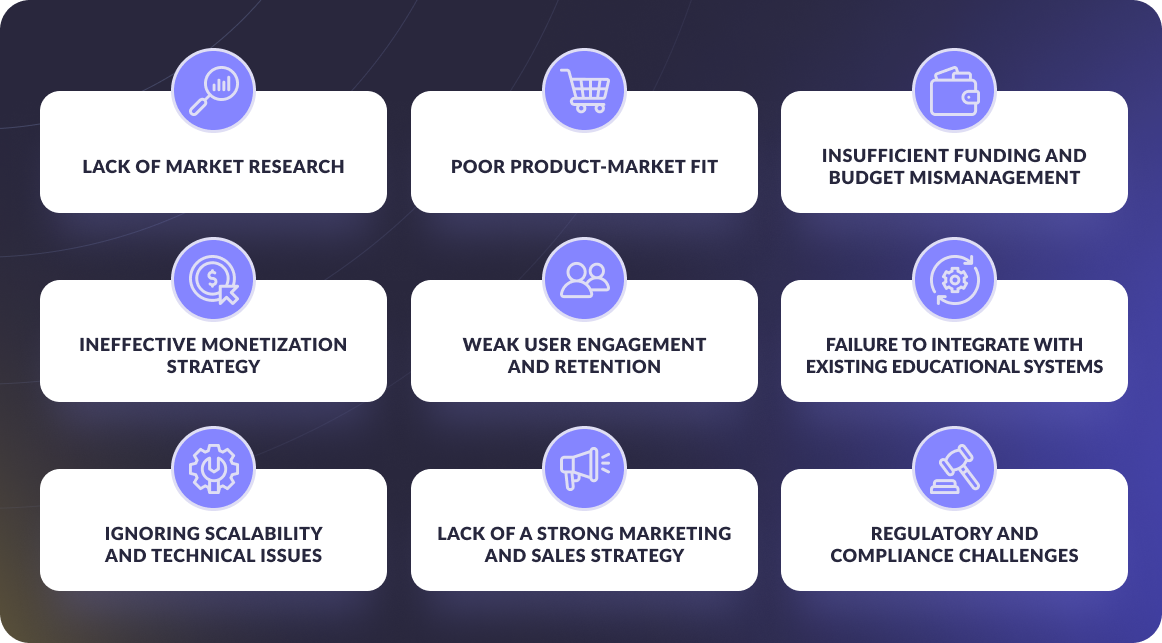Nowadays, the conventional education model faces challenges in adapting to rapidly changing global market demands. When fixed curricula and standardized testing do not leave space for individualized learning, students become disengaged, teachers burn out, and schools take a back seat. However, there is a gap between industry needs and old teaching methods, which makes it difficult for graduates to succeed.
Though educational costs keep increasing, high school enrollment is declining. The National Center for Educational Statistics experienced a 180% cost increase. Education has advanced in many developing nations, becoming a crucial resource. However, traditional methods no longer address the emotional needs of today’s students.
That’s where the educational technology startup sector delivers transformational changes. But how do you ensure that you do not fail this competition? This article will show EdTech startup transformations in education, examining the most popular startup failures and showing the top EdTech startups.
Reasons why EdTech startups keep failing in 2025
Research indicates that 90% of startups fail, and digital education firms are no exception. A boom in the worldwide EdTech market, expected to reach $170.8 billion from 2025 to 2029, will not protect numerous promising emerging companies from failure.
Why? The success of an excellent product doesn’t guarantee a market hit. The EdTech sector remains challenging even when technology alone doesn’t establish a presence. Therefore, you must recognize different common failure points during startup development. Now, we will explain how to identify the primary reasons behind online learning venture failures and how to avoid them.

1. Lack of market research
Young enterprises commonly create major faults by building their products without first understanding market demands. The education industry operates with multiple stakeholder groups, including students. The same goes for teachers, schools, businesses, and policy organizations with varying requirements.
Startup ventures frequently presume that exceptional learning software combined with AI tutor technology automatically generates user adoption. The success of product adoption depends on understanding students’ and mentors’ actual needs since neglecting genuine problems can result in product failure. To achieve widespread adoption, a young enterprise in the digital world should focus on developing solutions with maximum usability alongside integrated features and direct feedback channels. Many gamified learning platforms have failed because they focus too much on flashy features instead of addressing real learning problems.
Genuisee advice: If you plan to produce new products, verify the product concept first. Conduct user surveys and interview teachers to develop prototypes for actual testing with instructors and students. Market failure becomes likely when founders introduce products without proper market analysis, which results in a lack of demand and product obsolescence.
2. Poor product-market fit
Educational technology devices targeting the specific learning requirements of students and mentors demonstrate the highest possibility of success. EdTech emerging companies often start with attractive concepts they have not assessed to see if they align with real-life school standards and educational practices. These products lack market relevance because they exist without a fundamental understanding of customer needs and direct user information, making them unnecessary or challenging to integrate.
So, what’s the deal?
If you create an AI-powered tutoring system, ensure it offers personalized education. However, your software must adjust learning sequences according to student progress. The productivity of these platforms often suffers because their interfaces can be too complex for both educators and students.
Learning to use educational platforms can sometimes be challenging. This problem is worsened by ineffective onboarding and a lack of integration with existing learning management systems. School districts and mentors refrain from adopting educational products that fail to follow approved curriculum guidelines or Internet teaching criteria.
Education startups that succeed adopt different business models during their development. These institutions focus on studying new ideas, running experimental programs, and multiple enhancements through direct feedback from the field. The organization collaborates with school districts, universities, and individual mentors to develop solutions that match current teaching approaches. Educational technology solutions need a perfect fit for the market to succeed in the challenging EdTech sector.
3. Insufficient funding and budget mismanagement
A large number of EdTech innovation companies start with ambitious ideas yet fail because they lack proper financial planning, which rapidly depletes their resources. Even promising EdTech businesses to collapse before achieving maximum growth if they fail to get suitable funding or handle their expenses properly.
The rise of digital learning in 2022 started changing the way we learn. It attracted numerous new EdTech ventures that began their path. The fast development of the new learning platform led to high costs for creating and promoting products. Companies underestimated the time it would take to attract users. They received significant initial investments but wasted them by adding features that users did not request. As a result, companies struggled to get more investments because their financial value did not increase, and their profit plan was unclear.
Many company founders miscalculate the expenses needed to attract users to their platform and sustain excellent online learning systems across various global markets. Emerging educational companies face challenges because they purchase excessive technology systems and add too many employees before verifying their business concepts. Reliable growth has characterized entities such as Course Hero since they prioritize spending on product development while maintaining a profitable revenue stream.
Genuisee advice: Successful operation in the educational technology market requires online learning ventures to obtain funding while possessing a detailed strategy. Meanwhile, you should distribute funds effectively to support operations and continuously improve learning quality alongside financial sustainability. Young enterprises that do not handle their budgets effectively will increase the number of companies that go bankrupt in the education sector.
4. Ineffective monetization strategy
A standalone, extraordinary educational technology product fails to sustain or expand its operations because it lacks a profitable financial model. Traditional pricing approaches do not create appropriate solutions for schools, students, or educational institutions operating in EdTech. Your company’s valuation and growth depend heavily on correct pricing models and understandable revenue sources.
Here’s a list of common problems that EdTech companies face when creating their money-making plans:
Many education companies create complex pricing approaches that combine various tiers with excessive features, which confuse their users about the services they receive. Most educational organizations value pricing simplicity because tight budgets constrain their capabilities.
Understanding school budgets is essential for succeeding in K-12 learning platforms and online courses. Educational institutions will quickly reject pricing models that don’t align with their budget needs and those that impose high fees per student.
Institutional budgets work differently from regular businesses, making it hard for schools and universities to adopt educational solutions. Moreover, you can lose potential sales if prices are not aligned with educational institutions’ operations.
E-learning companies that only use subscription models for their solutions fail to explore alternate licensing structures, including pay-per-use models, because these would suit their target users better.
Users who fail to understand what they gain from a product will not consider paying for it. Various digital learning enterprises do not clearly express how their products enhance student learning results and streamline educational administration tools for teachers.
Successful examples like Duolingo and Khan Academy maintained their growth by continuously adjusting their revenue-generating approaches. These companies create profitable pricing strategies that fit education budgets and appeal to schools and students worldwide.
5. Weak user engagement and retention
User retention is a significant challenge for educational technology startups. These companies often struggle to keep their users engaged because users lose motivation and interest when dropout rates rise. This is especially true for students and educators who don’t receive individualized attention. As a result, retention rates drop significantly.
When users leave the platform, they miss out on valuable learning experiences. Keeping users engaged from the start is crucial; otherwise, even the most advanced education technology will become irrelevant.
Here’s why this happens:
Every student learns at a different speed and has a preferred learning style. When users face learning experiences that don’t match their pace, they may feel frustrated and drop out of the program. Many emerging companies lose many potential students because they lack these personalized features.
Online learning platforms often have boring content. They provide monotonous lesson materials without interactive features or varied content, which can lead to student disinterest. Keeping students engaged requires diverse platforms that include questions, competitive elements, and team project tools.
Any learner needs real-time feedback to track their progress and improve. Without these, there can be trust issues between educators and students, as well as among students. As an idea, provide customized quizzes and tools for evaluating performance for strong user motivation.
Many students stop using the platform because it is hard to navigate. Learning platforms for K-12 schools should be user-friendly to help kids and less tech-savvy teachers. A poor student experience disrupts learning, leading to student disappointment and dropouts.
Both students and educators lose interest when they don’t see how the platform helps students achieve their learning goals. Users who want specific feedback from language learning platforms find little value in those without clear objectives and measurable interaction.
Companies like edX achieve student retention through their courses by combining interactive elements with peer dialogue and assessment systems. Top companies actively follow user needs and behaviors together with their goals to maintain user engagement.


Thank you for Subscription!
6. Failure to integrate with existing educational systems
Emerging company development faces the greatest challenge when establishing complete system integration with current educator and student operating networks. Platform failure often occurs when educational technology does not agree with LMS infrastructure or pass required compliance tests. Schools, universities, and training institutions must adopt new educational tools with complete system integration to enhance learning efficiency, simplify workflows, and ensure data security.
Here’s the problem:
Many online education providers face challenges because their tools need to work well with popular Learning Management Systems (LMS) like Moodle, Blackboard, and Canvas. Schools integrate these systems into their daily operations, so administrators and teachers will likely reject new solutions that do not connect to these core platforms. Yet, why? Teachers juggling multiple tools for grading, messaging, and assignment management create significant problems for students and teachers. This complex setup can overwhelm most users, leading them to give up.
Local educational institutions also have strict rules about privacy and data protection. Your solution must meet these requirements. Schools will refuse to use your software if you fail to protect data or manage user consent properly. When developing products, you must pay close attention to compliance standards, especially health-related learning data, which must meet FERPA and GDPR guidelines.
Educational technology platforms that don’t align with current curriculum standards struggle to find opportunities for use. These platforms will not be adopted if they don’t consider the guidelines teachers must follow. The success of educational technology tools hinges on meeting learning goals to gain the support of schools and institutions.
Schools and educational institutions rely on Student Data Systems to organize and manage student information. Schools aim to reduce the need to enter the same information multiple times across different platforms. Your young enterprise’s success depends on how well its solutions fit current systems, making them easier for students and teachers.
Google Classroom effectively addresses integration challenges and is a successful example for many educational systems. It is essential for many school systems globally because it offers flexibility and an easy experience for users with various LMS.
7. Ignoring scalability and technical issues
Have you ever attempted to use a platform that gave you errors at critical moments? The platform loading process becomes excessively prolonged until you lose hope it is worth your time. EdTech emerging companies regularly deal with this matter, especially during their early development period, because they emphasize product coolness more than lasting scalability features.
Learning moments experience serious interruptions among students and educators due to technical problems, such as long loading delays and system crashes. A failed system leaves students in online education classes and content-accessing groups unable to access their educational content due to system load capacity limitations. The lack of scalability in your platform against increasing user numbers results in quick user abandonment of your young enterprise.
Let’s outline important requirements:
Education technology companies commonly overlook the need to provide adequate infrastructure to meet the increasing requirements of their customer base. If your platform cannot manage the growing traffic, it can collapse.
Slow performance always impacts User Experience (UX). When platforms experience extreme load and sluggish performance, students tend to leave, resulting in reduced total retention.
When you expand your user base, you also collect more data. When proper management infrastructure is lacking, website performance problems and data loss occur.
Due to increased vulnerability, the platform’s growth will create more opportunities for cyber security threats. Technical system weaknesses may expose student-sensitive information to protection risks.
By the way, Babbel encountered scalability problems with user expansion because it operated as a leading language learning platform. To address this situation, it adopted cloud technology and added AI features that individualize learning paths. This change made the platform faster and strengthened user loyalty.
8. Lack of a strong marketing and sales strategy
While natural growth helps meet key goals, it is not enough for lasting success. Without focused sales and marketing efforts, your EdTech platform will struggle to stand out in a competitive market.
Think about the most popular education platforms. They did not gain users on-demand. Instead, they created a comprehensive marketing strategy to ensure their solutions reached schools, students, and educators. Poor marketing can prevent even the most innovative EdTech solutions from reaching potential users.
Here’s what can happen if your emerging company doesn’t prioritize marketing and sales:
Potential users will not know about your platform because proper marketing does not exist. Your education technology risks losing essential users and potential partners who might not discover your services.
A powerful marketing strategy lets you clarify your distinctive benefits to target customers. Your product will miss out on adopters if you fail to explain what sets your platform apart and how it benefits educators, students, and institutions.
EdTech innovation companies fail when they do not create essential relationships with key individuals. Expanding your product requires direct relationships with educational decision-makers at schools, universities, and education companies. Not reaching out and networking with others will prevent you from finding meaningful partnership opportunities.
Sales will suffer if you lack an adequate system for generating new leads. Using social networks and content production for targeted sales will help you engage customers through email marketing campaigns.
Sales and marketing strategies are crucial, as Coursera’s case study shows. The company partnered with top educational institutions to gain international recognition for its programs. Coursera’s strong position in online learning comes from its focus on building awareness through content marketing, strategic alliances, and social media outreach.

More from our blog
LMS features comparison: find the best learning management system
Your shortcut to the right LMS: compare features, pricing, and future-ready tools all in one guide.
Read more9. Regulatory and compliance challenges
Regulations and compliance requirements are essential building blocks for the business. With the growing focus on data protection laws and student privacy rules, you must stay updated on the standards that govern educational technology. But what if you don’t?
Not following these regulations can lead to serious problems, including hefty fines, damage to reputation, and even the shutdown of the organization.
In the United States, EdTech companies must comply with the Family Educational Rights and Privacy Act (FERPA) to keep student information private. The European Union’s General Data Protection Regulation (GDPR) provides educational and personal data management guidelines. Companies that do not follow these rules face financial penalties and harm their reputation.
If your young enterprise does not prioritize compliance, you may face negative consequences:
Data security problems occur when data management fails to follow appropriate procedures, resulting in breaches. They expose private information and break trust relationships between users, their institutions, and students’ parents. The consequences of a data breach include legal actions and sustained damage to your company’s brand.
Schools or institutions will reject your EdTech platform solution if they discover regulatory non-compliance. Educational institutions need assurance about student privacy protection, so failure to maintain privacy standards leads to business loss.
If you want to expand internationally, understand that each market has operational requirements. For example, your existing educational regulations, particularly regarding education laws, may not apply to different regions where you operate.
When they fail to respect data privacy regulations, they risk heavy fines and legal consequences. Your platform might be closed while you are subjected to substantial financial penalties, which you could have prevented in the first place.
A prime illustration of compliance exists within Schoology, one of the top learning management systems. The company took various proactive measures to guarantee full compliance of its platform with FERPA and GDPR. Substantial security protocols and open privacy policy implementation helped Schoology establish trust with educational institutions that use its standards to protect their students’ data systems.
How we helped startups reach new heights
MyTutor. Online tutoring provider
UX/UI design and web development: We created an intuitive interface that makes it easy for users (college students and tutors) to book behavior training.
DevOps and QA/QC testing: We used 24/7 help via Opsgenie to ensure platform uptime and reliability.
Technology stack: Utilized ReactJS, Java, AWS, PostgreSQL, and other cutting-edge gear to build a scalable and strong platform.
Outcome:
Developed a web platform with better stability and scalability.
The platform became more consumer-friendly by automating lesson scheduling based totally on consumer possibilities.
Finance Unlocked. Video learning platform for finance professionals
UX/UI design and web development: We created an appealing, person-friendly layout for economic specialists to access instructional content.
Platform migration: We migrated the platform from WordPress to ReactJS and Laravel to increase performance and skills.
SCORM API and SSO development: Developed SCORM API for integrating different platforms and implemented Single Sign-On (SSO) for company clients.
Outcome:
Improved studying performance through interactive video courses and materials with the aid of top industry professionals.
Finance professionals can easily access guides through both cellular and web systems.
Booster Prep. Online learning platform for test preparation
Platform development: We created a user-pleasant platform that helps and includes interactive practice assessments, educational motion pictures, and personalized have-a-look-at plans.
Mobile development: Developed a React Native mobile app to ensure users can access assets from any device.
Data migration and CMS development: Migrated statistics from the vintage platform and constructed an easy-to-use Content Management System (CMS) for administrators.
Outcome:
Enhanced user engagement with individualized plans and interactive content.
The cellular app allowed users to look at on-the-cross, increasing platform engagement.
These instances exhibit our know-how in growing scalable, consumer-pleasant systems while addressing the particular desires of every young enterprise. Through tailored development, we assisted those organizations in developing and scaling efficaciously.
How can Geniusee help your startup grow in the EdTech industry?
The EdTech industry is growing quickly, offering new opportunities and unique challenges. Your Learning technology startup needs more than great ideas to succeed in this competitive market. It must create engaging learning platforms and navigate various regulations. A strong market understanding is essential for performing well and adapting quickly.
If you need help, our team is here to support you every step of the way, especially with individualized learning platforms, artificial intelligence, machine learning integration, and improving user retention. Geniusee creates educational solutions that meet both functional needs and technical security standards to ensure your product works well. Our experts create sustainable systems that can grow with your business, and we have a large portfolio to prove it.
Consult with Geniusee now if you want to turn your dreams into practical reality by becoming an educational technology leader. Contact us right now for a discussion. Our dedication extends to providing the necessary tools, expertise, and successful worldwide EdTech market strategies for new startups and scaling ventures.





















